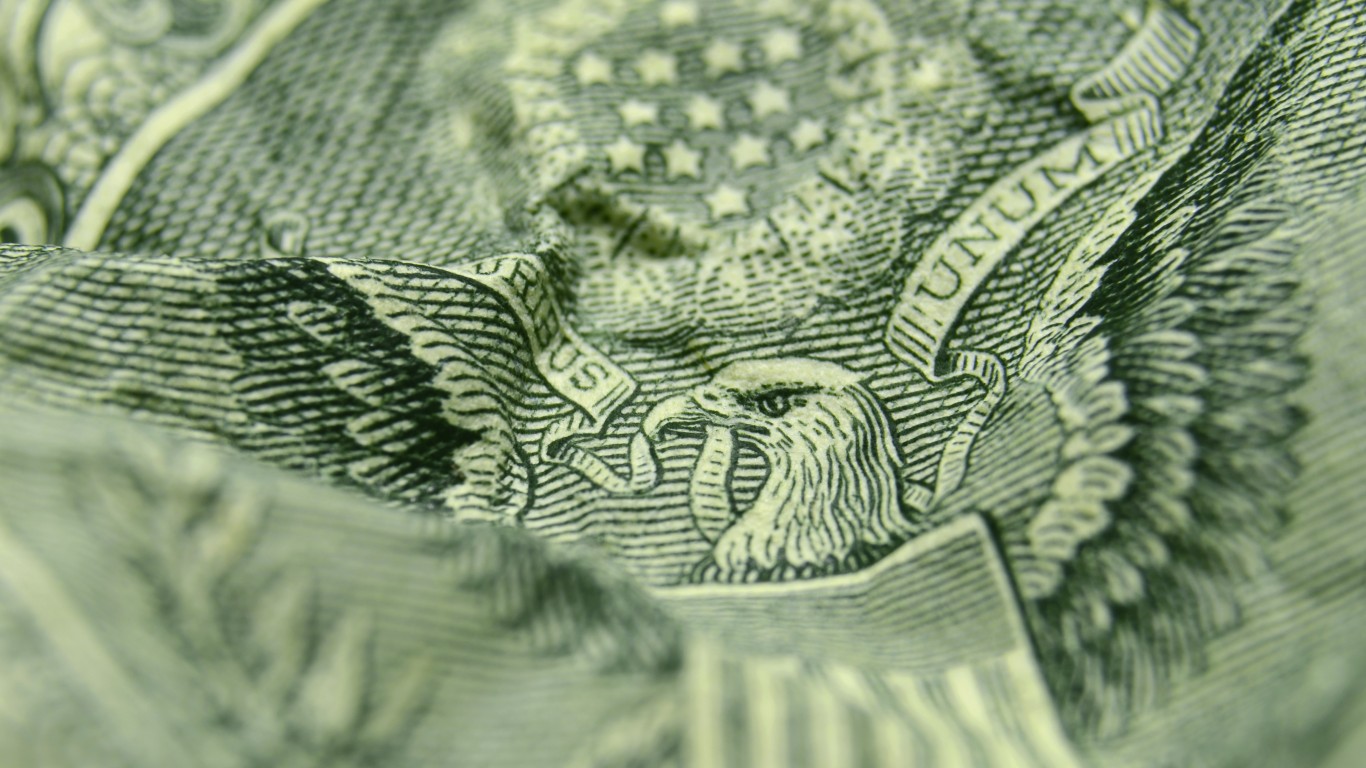
The federal deficit hit an all time high of over $28 trillion in March 2021. Unlike the federal government, however, nearly all states are constitutionally required to have a balanced budget and depend on multiple sources of tax revenue to fund operations. No two state tax structures are exactly alike, and in some parts of the country, Americans pay fewer taxes than in others.
One of the primary revenue sources for most states is income tax. Depending on the state, personal income tax can account for over one-third of overall tax revenue — a tax burden shouldered exclusively by workers and investors. There are, however, eight states that do not levy any personal income taxes, and one additional state that only taxes income from interest and dividends.
Using data compiled by tax policy research organization Tax Foundation, 24/7 Wall St. identified the nine states with no income tax. All data included in the article came from the “Tax Foundation’s “Facts & Figures 2021: How Does Your State Compare?” report.
Most states that do not levy a personal income tax make up for that potential revenue through other channels. Severance taxes on resource extraction and sales taxes that take advantage of a strong tourism industry are two such examples. These revenue sources offset the lack of an income tax and generally reduce the overall tax burden on state residents. Here is a look at the states where you’ll pay the most in taxes.
Some states on this list are also generating revenue through the regulation and taxation of recreational marijuana. Over the last decade, 16 states have legalized recreational marijuana use — and the three of them that are on this list are making tens of millions and hundreds of millions of dollars each year in tax revenue. Here is a look at the states where marijuana is legal.
Click here to see the states with no income tax.
To determine the states with no income tax, 24/7 Wall St. reviewed data on state tax codes from the 2021 Facts and Figures report of the tax policy research organization Tax Foundation. Data on personal income per capita in 2019, state tax collections per capita in 2019, state debt per capita as of 2019, property tax, general sales tax, individual income tax, corporate income tax, and other taxes as a percentage of total state revenue came from the Tax Foundation.

1. Alaska
> 2019 personal income per capita: $62,806 (9th highest)
> 2019 total state tax collections per capita: $2,434 (10th lowest)
> 2019 state debt per capita: $8,285 (4th highest)
> Largest source of state+local tax revenue: Property tax (45.6% of total)
Alaska is one of nine states that does not levy an individual income tax, or taxes on interest and dividends. A resource-rich state, Alaska is in a unique position to shift tax burdens from individual residents to oil and gas extraction companies. Alaska has some of the largest oil fields in the United States. Because of the revenue it derives from these fields, not only does the state not levy an individual income tax, but also it does not levy a sales tax â although some local governments are allowed to levy their own sales taxes. Per capita corporate income tax collections in the state totalled $455 in fiscal 2019, more than in all but two other states.
The largest share of total tax revenue in Alaska comes from property tax. State and local governments derived 45.6% of total tax revenue from property tax in fiscal 2019, far more than the 31.1% national average.
[in-text-ad]

2. Florida
> 2019 personal income per capita: $52,426 (24th lowest)
> 2019 total state tax collections per capita: $2,086 (the lowest)
> 2019 state debt per capita: $1,212 (4th lowest)
> Largest source of state+local tax revenue: General sales tax (38.3% of total)
With a warm climate year-round in many parts of the state, Florida is one of the most popular tourist destinations in the United States. The Sunshine State welcomed 131.4 million domestic and international visitors in 2019, and slightly fewer — 86.7 million — in 2020 due to the COVID-19 pandemic. Due in part to tourist spending, the state does not levy an income tax on its residents. Instead, Florida charges a 6% sales tax, which generated per capita revenue of $1,304 in fiscal 2019 — more than in all but seven other states. Revenue from general sales taxes account for 38.3% of Florida’s annual revenue, more than any other tax.
Excise taxes on wine and beer in Florida are also each among the top 10 highest of all states.

3. Nevada
> 2019 personal income per capita: $51,161 (22nd lowest)
> 2019 total state tax collections per capita: $3,164 (25th highest)
> 2019 state debt per capita: $1,074 (2nd lowest)
> Largest source of state+local tax revenue: General sales tax (41.3% of total)
Much like Florida, Nevada’s tourism industry generates enough revenue that state residents are spared the burden of an income tax. Before the COVID-19 pandemic, which cut tourism in half, Las Vegas reported more than 42 million visitors a year. Through a 6.85% state sales tax — higher than in all but a dozen states — Nevada brought in $1,786 per resident in fiscal 2019, more than the per capita sales tax revenue of all but two other states. General sales tax accounts for 41.3% of Nevada’s annual revenue, more than any other tax.
Like several other states, Nevada is now raising revenue through recreational marijuana sales. Wholesale, marijuana is subject to a 15% excise tax in the state, and an additional 10% tax at the retail level.

4. New Hampshire
> 2019 personal income per capita: $63,502 (8th highest)
> 2019 total state tax collections per capita: $2,184 (5th lowest)
> 2019 state debt per capita: $5,589 (10th highest)
> Largest source of state+local tax revenue: Property tax (63.8% of total)
New Hampshire is the only state that does not tax employment income but does tax interest and dividend income. Through a 5% tax on interest and dividends, New Hampshire collected $90 per resident in fiscal 2019.
Without a revenue stream from personal income taxes, New Hampshire levies a 7.7% corporate income tax, which generated $612 per capita in fiscal 2019, the most of any state. The largest share of state tax revenue in New Hampshire, however, comes from property taxes. Per capita state and local property tax collections in New Hampshire totalled $3,362 in fiscal 2018, more than in every state except New Jersey. Property taxes account for 63.8% of all state and local tax revenue in New Hampshire.
[in-text-ad-2]

5. South Dakota
> 2019 personal income per capita: $53,962 (22nd highest)
> 2019 total state tax collections per capita: $2,193 (7th lowest)
> 2019 state debt per capita: $3,967 (16th highest)
> Largest source of state+local tax revenue: General sales tax (39.3% of total)
One of the states with the lowest tax burden in the country, South Dakota has neither a personal income tax nor a corporate income tax. The largest source of tax revenue for the state is sales tax, which accounts for 39.3% of total tax revenue. While South Dakota’s per capita sales tax revenue of $1,251 is higher than in all but half a dozen other states, its 4.5% state sales tax rate is lower than that of most other states.
Low taxes appear to have put South Dakota in a worse fiscal position than most other states. The state’s per capita debt in 2019 totalled nearly $4,000 — more than the comparable figure in the majority of other states.

6. Tennessee
> 2019 personal income per capita: $48,684 (16th lowest)
> 2019 total state tax collections per capita: $2,171 (3rd lowest)
> 2019 state debt per capita: $986 (the lowest)
> Largest source of state+local tax revenue: General sales tax (40.7% of total)
This year, Tennessee joined the ranks of states that do not levy any income tax. In 2015, the state taxed income from dividends and interest at a 6% rate. That rate was reduced by 1 percentage point each year since and is now eliminated after sitting at 1% in 2020.
Tennessee compensates for a lack of income tax revenue, in part, by having high sales tax. The state’s 7% sales tax rate is the second highest in the country. General sales taxes alone account for 40.7% of total state and local tax revenue. The state also levies an excise tax on beer sales at a rate of $1.29 per gallon, more than any other state.
[in-text-ad]

7. Texas
> 2019 personal income per capita: $52,813 (25th lowest)
> 2019 total state tax collections per capita: $2,184 (6th lowest)
> 2019 state debt per capita: $1,855 (8th lowest)
> Largest source of state+local tax revenue: Property tax (44.0% of total)
Texas is home to about 40% of proved oil reserves in the United States — and accounts for 40% of total U.S. crude oil production. Though the Lone Star State does not have a standard corporate income tax rate, it does levy severance taxes on resource extraction — and oil and gas companies operating in Texas generated $16.3 billion in revenue for the state in 2019. Partially as a result, the state is able to fund operations without levying a personal income tax.
Tourism is also a boon for the state government, as Texas collected $1,315 per capita in general sales tax in 2019, more than all but six other states. The largest share of tax revenue collected by the state and local governments is property tax, which accounts for 44% of all tax revenue.

8. Washington
> 2019 personal income per capita: $64,758 (6th highest)
> 2019 total state tax collections per capita: $3,676 (12th highest)
> 2019 state debt per capita: $4,673 (14th highest)
> Largest source of state+local tax revenue: General sales tax (36.4% of total)
Annual income per capita in Washington stands at $64,758, more than in all but five other states in the country. The state does not benefit from its relatively high earning residents, however, as it does not levy a personal income tax.
Washington does benefit considerably from how its residents spend their money. The state levies a statewide general sales tax of 6.5% — fifth highest in the country. Partially as a result, per capita sales tax revenue in the state totalled $2,186 in fiscal 2019, the most of any state other than Hawaii. Sales taxes account for 36.4% of total state and local tax revenue in Washington, more than any other tax.

9. Wyoming
> 2019 personal income per capita: $62,189 (10th highest)
> 2019 total state tax collections per capita: $3,647 (13th highest)
> 2019 state debt per capita: $1,525 (7th lowest)
> Largest source of state+local tax revenue: Property tax (39.7% of total)
Much like Alaska and Texas, Wyoming is able to fund state operations without levying a personal income tax, largely due to its natural resources. Wyoming is one of the largest producers of oil and natural gas, and though it does not levy a standard corporate income tax, it does levy severance taxes on resource extraction. The COVID-19 pandemic, which cut sharply into energy demand, translated to a revenue shortfall of more than $1 billion in Wyoming.
Sales taxes account for a considerable share of Wyoming’s revenue. The state collected $1,331 in sales tax revenue per resident in 2019, more than all but five other states. But the largest source of tax revenue comes from taxes on property. Property taxes account for nearly 40% of total state and local tax revenue.
Are You Ahead, or Behind on Retirement? (sponsor)
If you’re one of the over 4 Million Americans set to retire this year, you may want to pay attention.
Finding a financial advisor who puts your interest first can be the difference between a rich retirement and barely getting by, and today it’s easier than ever. SmartAsset’s free tool matches you with up to three fiduciary financial advisors that serve your area in minutes. Each advisor has been carefully vetted, and must act in your best interests. Start your search now.
Don’t waste another minute; get started right here and help your retirement dreams become a retirement reality.
Thank you for reading! Have some feedback for us?
Contact the 24/7 Wall St. editorial team.
 24/7 Wall St.
24/7 Wall St.

